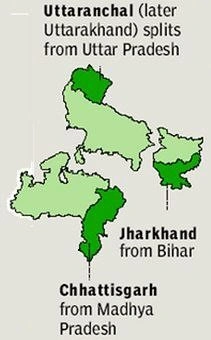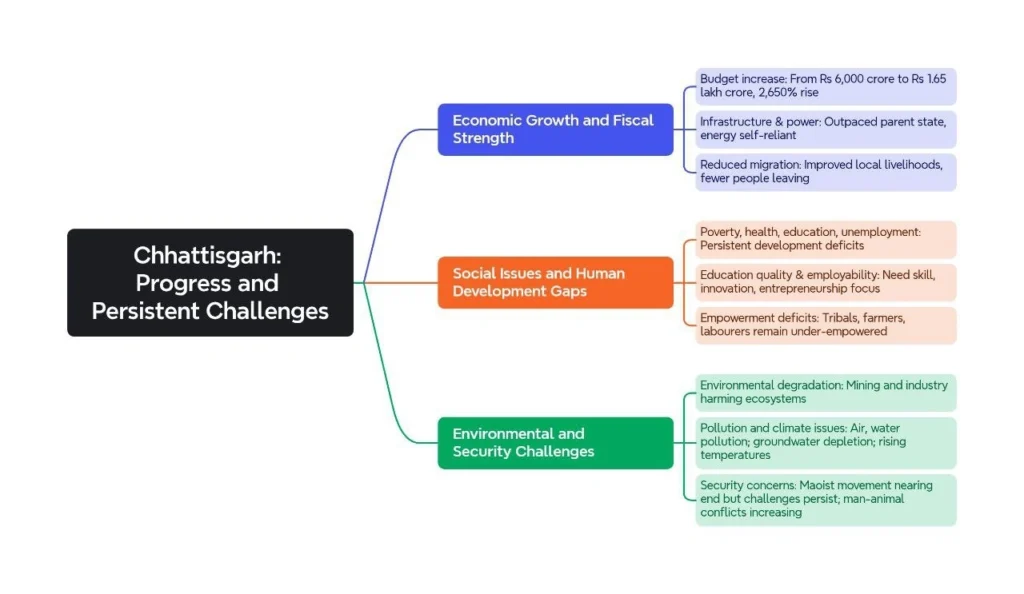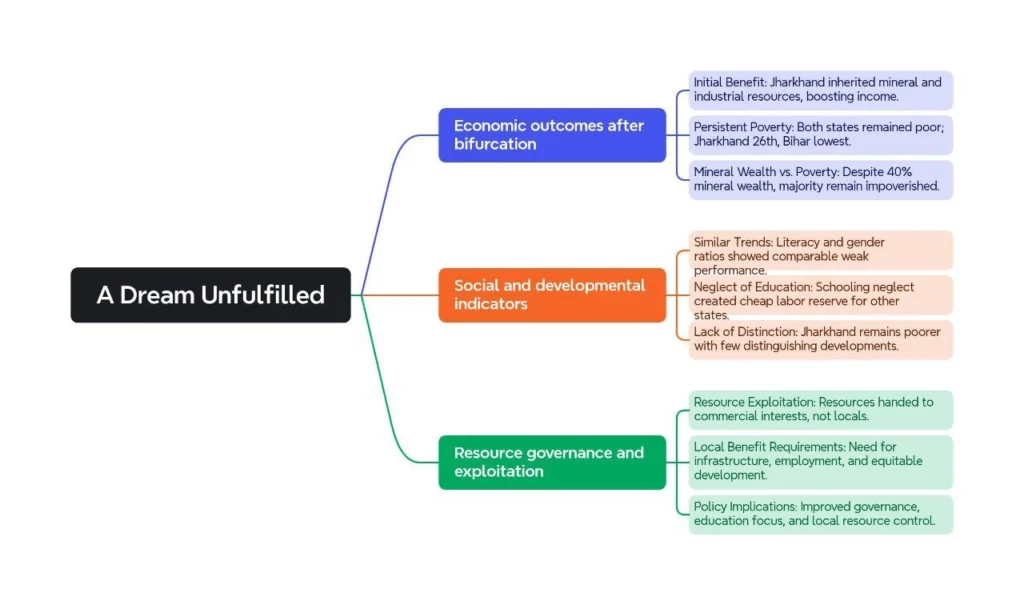Paper: GS – II, Subject: Polity, Topic: Legislature, Issue: Formation OF Uttarakhand, Chhattisgarh and Jharkhand.
Context:
Chhattisgarh, Uttarakhand, and Jharkhand were formed on November 1, 2000, reflecting demands for better representation, respect for local identity, development, and relief from neglect and exploitation by parent states.
Key Takeaways:
Behind Statehood Demand: Chhattisgarh:
Chhattisgarh, rich in coal and iron ore reserves, was once the most backward part of united Madhya Pradesh.

- Alienation: The region felt physically and emotionally distant from the Bhopal-based administration.
- Lack of Integration: Leaders felt emotionally disconnected from Madhya Pradesh.
- Distinct Identity: The region had its own geographical, linguistic, and cultural distinctions.
- Tribal Diversity: Home to a large tribal population (34%), with 42 distinct tribes.
Formation of Chhattisgarh: The demand for separate province of Chhattisgarh was raised by the Raipur Congress unit in 1924 and was also discussed in the Indian Congress at Tripuri.
- In 1954, when the State Reorganisation Commission was set up, the demand was put forward but was rejected.
- Again in 1955, the demand was raised in the Nagpur assembly of Madhya Bharat.
- In the 1990s, the Chhattisgarh Rajya Nirman Manch led mass strikes for statehood, gaining strong support from major political parties.
- National Democratic Alliance government sent the Separate Chhattisgarh Bill for approval to the Madhya Pradesh Assembly, where it was unanimously approved and then submitted to the Lok Sabha.
- The bill was passed in the Lok Sabha and the Rajya Sabha, which led to the creation of the state of Chhattisgarh on 1 November 2000.
Chhattisgarh: Progress and Persistent Challenges

Formation of Uttarakhand:
The demand for special rights for the Uttarakhand region dates back to 1815, gaining prominence in 1938 with Jawaharlal Nehru’s support.
- Despite early calls for separation from the plains, these were initially ignored.
- The demand resurfaced in 1952, with CPI leader P.C. Joshi advocating for a separate hill state.
- The formation of the Uttarakhand Kranti Dal in 1979 further solidified the idea among residents.
- A turning point occurred in 1994 when then UP Chief Minister, Mulayam Singh Yadav, implemented a 27% reservation for Other Backward Classes.
- This decision alarmed the predominantly upper-caste population in the hills, who feared an influx of ‘outsiders’ filling jobs and educational positions.
- This led to widespread demonstrations and rallies demanding statehood.
- In 1996, Prime Minister H.D. Deve Gowda announced the formation of Uttaranchal, and in 1998, the Atal Bihari Vajpayee government passed the Uttar Pradesh Reorganization Bill.
- Demand for a separate state eventually took the form of a mass movement that resulted in the formation of Uttarakhand as separate state on 9th November 2000.
Reasons and Outcomes of Demanding a Separate Uttarakhand State:

Formation of Jharkhand:
- Early Articulations (1912): The earliest demands for statehood were made by an emerging Adivasi middle-class intelligentsia.
- Chhota Nagpur Unnati Samaj (1928): The Samaj formally requested the Simon Commission to create an Adivasi province.
- Jaipal Singh Munda (1930s-1960s): Munda expanded the movement’s appeal by renaming the Adivasi Mahasabha as Jharkhand Party in 1949 and opening membership to non-tribals.
- Jharkhand Mukti Morcha (JMM) (1972): The JMM emerged from the merger of the Shivaji Samaj, the Marxist Coordination Committee, and the Sonot Santhal Samaj.
- Mass Mobilization: The JMM united various backward castes, Adivasis, peasants, and workers under a “red-green” banner.
- Grassroots Movements (1970s): The JMM led movements against exploitation by moneylenders (dhan katao andolan) and unjust state forestry practices (jungle katao andolan).
- BJP Support: The Bharatiya Janata Party (BJP) supported the idea of Jharkhand, creating a convergence of regional opinion in favor of statehood.
- Bihar Reorganization Bill (2000): Atal Bihari Vajpayee’s NDA government tabled the bill, which was eventually passed in August 2000.
- Finally, with the support from both RJD and Congress, the ruling coalition at the Centre led by the BJP cleared the Bihar Reorganisation Act in 2000, thus paving the way for the creation of a separate Vanachal state comprising Chota Nagpur Division and Santhal Pargana Division of South Bihar on 15 November 2000.
- Later the name of the state was changed from Vanachal to Jharkhand.
A Dream Unfulfilled:

Uttarakhand, Jharkhand, and Chhattisgarh were created to improve governance, promote regional development, and empower local identities, marking advances in decentralization and responsive federalism within India’s dynamic framework.
La Excellence IAS Academy, the best IAS coaching in Hyderabad, known for delivering quality content and conceptual clarity for UPSC 2025 preparation.
FOLLOW US ON:
◉ YouTube : https://www.youtube.com/@CivilsPrepTeam
◉ Facebook: https://www.facebook.com/LaExcellenceIAS
◉ Instagram: https://www.instagram.com/laexcellenceiasacademy/
GET IN TOUCH:
Contact us at info@laex.in, https://laex.in/contact-us/
or Call us @ +91 9052 29 2929, +91 9052 99 2929, +91 9154 24 2140
OUR BRANCHES:
Head Office: H No: 1-10-225A, Beside AEVA Fertility Center, Ashok Nagar Extension, VV Giri Nagar, Ashok Nagar, Hyderabad, 500020
Madhapur: Flat no: 301, survey no 58-60, Guttala begumpet Madhapur metro pillar: 1524, Rangareddy Hyderabad, Telangana 500081
Bangalore: Plot No: 99, 2nd floor, 80 Feet Road, Beside Poorvika Mobiles, Chandra Layout, Attiguppe, Near Vijaya Nagara, Bengaluru, 560040

